Previously we covered the seated Arnold press and wider programming implications and variables. Here we’ll focus on the Arnold press muscles worked and how the range of motion used impacts muscle activation.

What Is The Arnold Press?
The Arnold press is a dynamic exercise named after the iconic bodybuilder Arnold Schwarzenegger, who may or may not have integrated this movement into his training regimen to build his broad shoulders. No one knows for sure. What we do know is this variation of the dumbbell shoulder press Arnold targets multiple shoulder muscles through a combination of a shoulder press and rotation (1). It’s a variation that diverges from the standard dumbbell press with a twist, literally; as you lift the weights, you rotate your arms from a palms-facing-body position to palms-forward at the top of the lift.
The Arnold press is a great variation of the traditional overhead dumbbell press that works the anterior and lateral deltoid heads and the posterior deltoid to some degree.
Related: Seated Arnold Press: How to do That Weird Dumbbell Shoulder Press Exercise Variation
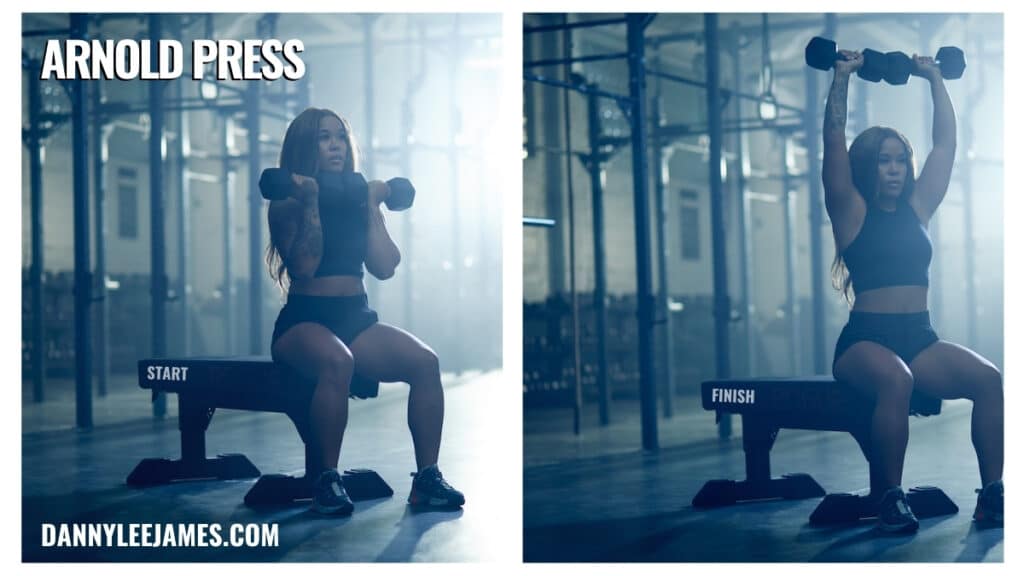
How To Do An Arnold Press
To perform the exercise, you can sit or stand with dumbbells at shoulder height with your palms facing your body. Arnold press requires you to bring the dumbbells up and rotate your wrists so your palms face outward at the top of the movement. Press the weights directly up above your head, engaging all three heads of the shoulders before returning the dumbbells to shoulder height.
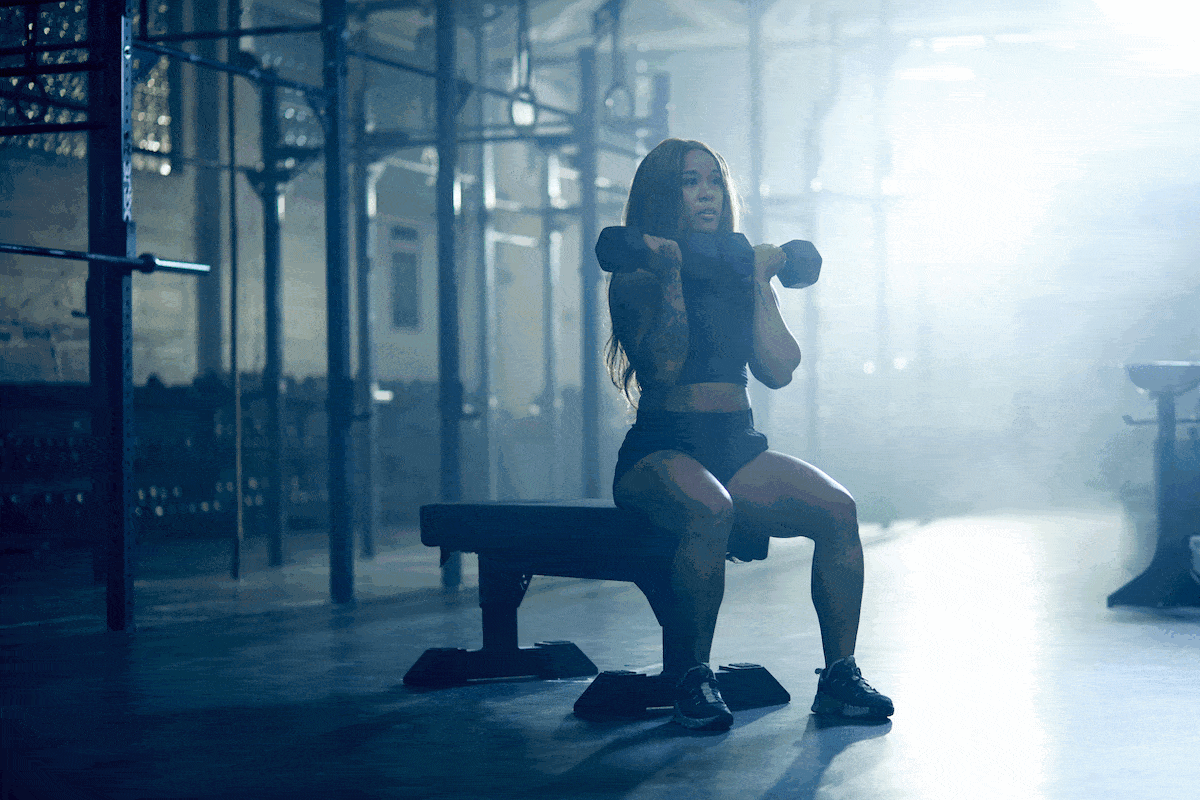
What Does Arnold Press Work? Really?
Mastering the Arnold press can help you build all three heads of the deltoid muscle, primarily the front and side delts. It also improves shoulder strength and stability and gives you an effective shoulder press variation to avoid training monotony and plateaus.
Digging deeper:
There are three main determinates of what muscles are working during pressing exercises and how much; direction of resistance, arm path and range of motion used.
These are impacted by the source of the load (e.g., cable or free-weights), your body position in relation to the source, and technique.
Direction of Load
The direction of resistance is relative to the position of the body and the operating lever of the target muscle.
In any dumbbell overhead press, the primary direction of resistance is vertical, opposing gravity. This vertical resistance mostly activates the deltoid muscles (particularly the anterior and lateral heads).
Variations in body position and pressing angle relative to that vertical load will alter the direction of resistance to emphasise different muscle groups or different portions of the movement curve. In the case of free-weight training, resistance will be greatest when the operating lever is perpendicular to the direction of resistance.
If the direction of resistance is more horizontal toward you as with a flat dumbbell bench press, relative activation of the pectoralis major increases, while still engaging the deltoids.
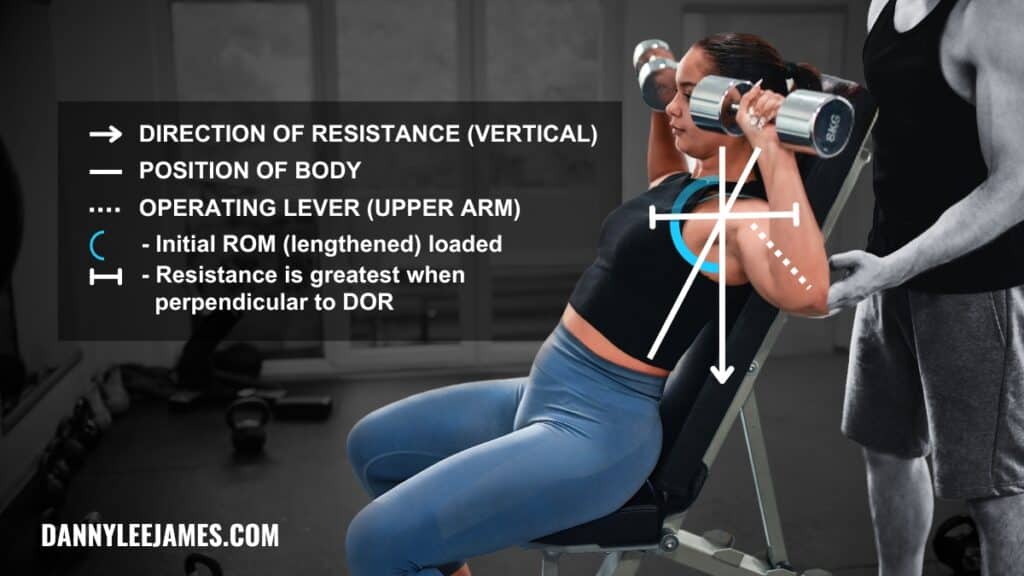
Performing a seated shoulder press using a very high incline only slightly off vertical will bias the front delts more than when completely upright. You’ll be pressing the dumbbells slightly forward and up, raising the dumbbells together over your face rather than your head.
Here the delts are working through longer muscle lengths and the resistance is greater during the bottom portion or initial range of the strength curve. You’ll also use slightly less trapezius and involve some upper portions of the pectoralis major.
This vertical direction of load is also why performing an Arnold press in two parts, moving between sagittal and frontal planes before pressing, instead of in one motion isn’t as effective. You’ll fatigue the delts and traps isometrically trying to get your arms into the start position of a traditional dumbbell press.
While there’ll be some muscular output required to stop, redirect and accelerate the dumbbells, it won’t contribute much to muscle hypertrophy.
Arm Path
With the upper arm being the moving lever of the target muscle, the arm path is crucial to determining muscle recruitment.
Pressing a pair of dumbbells above your head offers more freedom of movement and a variety of useful arm paths compared to a barbell.
For example, the Arnold Press begins with the arms in front of the body and allows them to finish closer together again at the top. The result is the anterior and medial portions of the deltoids work through a larger range of movement (1).
While the traditional dumbbell shoulder press maintains a more stable shoulder position throughout the lift, during an Arnold dumbbell press the arm also moves through a larger excursion of external and internal rotation.
This axial rotation of the humerus unique to this variation of dumbbell press might confer shoulder mobility benefits beyond the gym. These combined motions when performing the Arnold shoulder press allow the delts to be targeted through a greater range than with other pressing exercises.
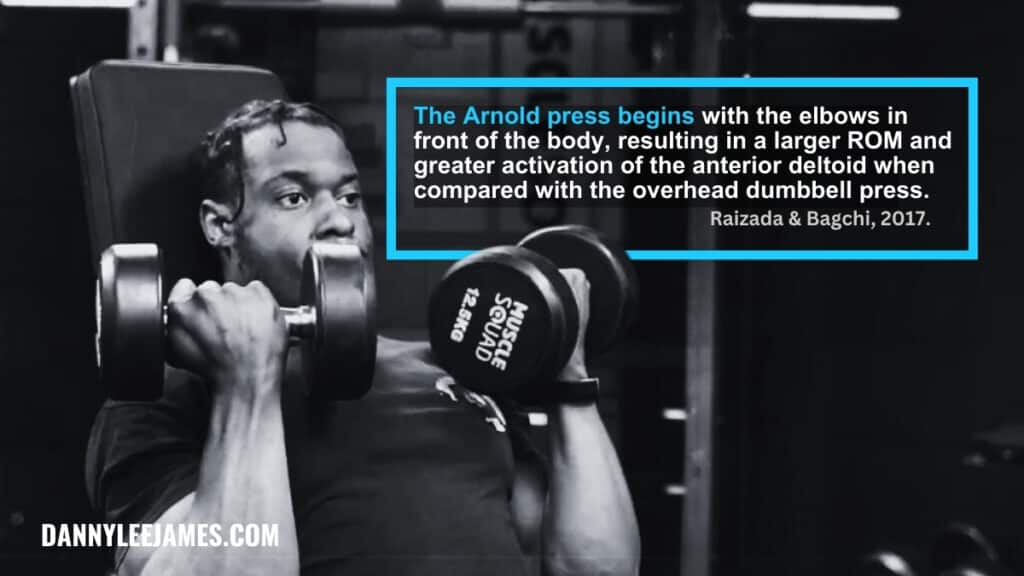
Pressing in the Sagittal Plane
With dumbbells held in front of your shoulders when performing Arnold presses, we see a more extensive arc of movement resulting in greater activation in the front and side delts, compared to when pressing wider. This is a big part of what makes the Arnold Press more effective for hypertrophy-focused training.
Pressing in the Frontal Plan
Traditional overhead presses and military presses performed with a wider arm position (abduction) reduce the range of motion. This can lead to decreased muscle recruitment and overall muscle activation. The wider arm position might also shift some of the workload from the deltoids to the upper pectoral muscles.
This is not to say these are not effective at building muscle but it may be slightly less productive if the primary goal is shoulder development. Ultimately, the front delts are worked through any press, raise, and fly variant or movements with resisted shoulder flexion and adduction.

Range of Motion in the Arnold Press
This is where the Arnold Press wields its hypertrophy prowess.
Research has consistently shown training a muscle through larger active ranges tends to be a better hypertrophy stimulus. A few reasons for this are that you get more time under tension, increased metabolic stress, a better stretch and overall muscle activation. You also recruit more muscle fibers across the length of the muscle.
Adjusting the seat back to 70-80 degrees during an overhead dumbbell press will shift loading towards the initial phase of the movement. Studies have shown training the early ranges of an exercise also promote better muscle hypertrophy because it matches the strength curve of most skeletal muscles.
But that’s not all.
It’s worth noting how using different ranges of motion can also target different muscles with the same exercise (2).
Half squats, for example, will cause a greater relative contribution from the quadriceps. You’ll also see this play out in a military press where the upper arms move predominately in the front plane.
When performing overhead barbell press partials through the top or shortened position, the anterior deltoid has better leverage, taking over from the middle delts as the arms pass horizontal (2).
Partials at the bottom or lengthened position (shoulder more adducted) will involve more of the middle deltoids which are the primary shoulder abductors up to 90 degrees of shoulder elevation.
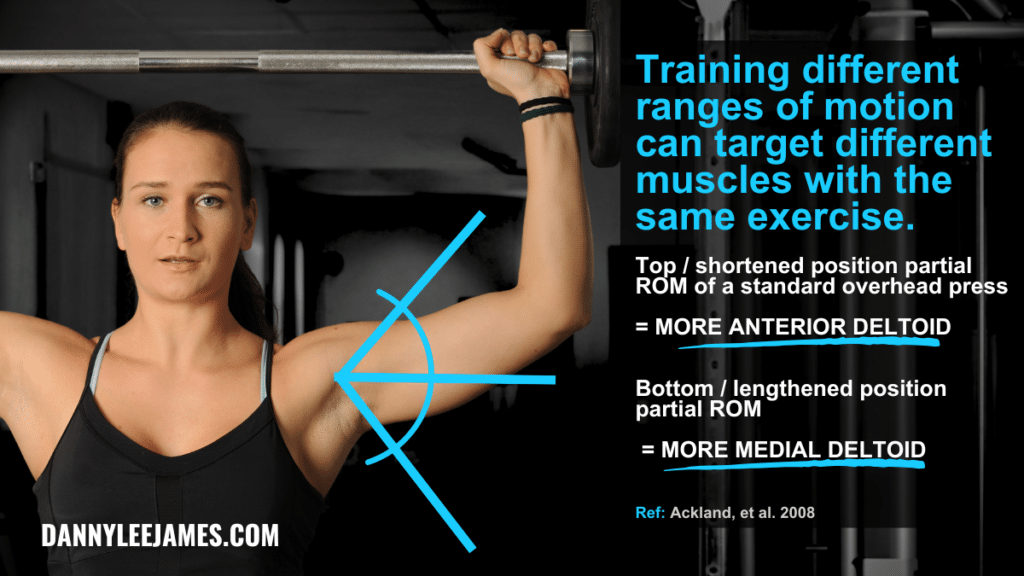
Arnold Press Muscles Worked
This rotation activates the shoulders, particularly the deltoids, the triceps, the upper back, and even your core. The movement not only targets the anterior and medial deltoid but also promotes the stability and mobility of the shoulder joints.
In one study researchers compared anterior and medial deltoid muscle activity during variations of the shoulder press. The Arnold press demonstrated significantly more activation of the front and side shoulder muscles compared to the overhead dumbbell press.
In both movements, the anterior deltoid acted as the primary mover, showing higher muscle activation in comparison to the medial deltoid.
So, while both exercises target the deltoids, the Arnold press may provide slightly more emphasis on the anterior and medial deltoids due to the initial starting position and larger range of movement overall.
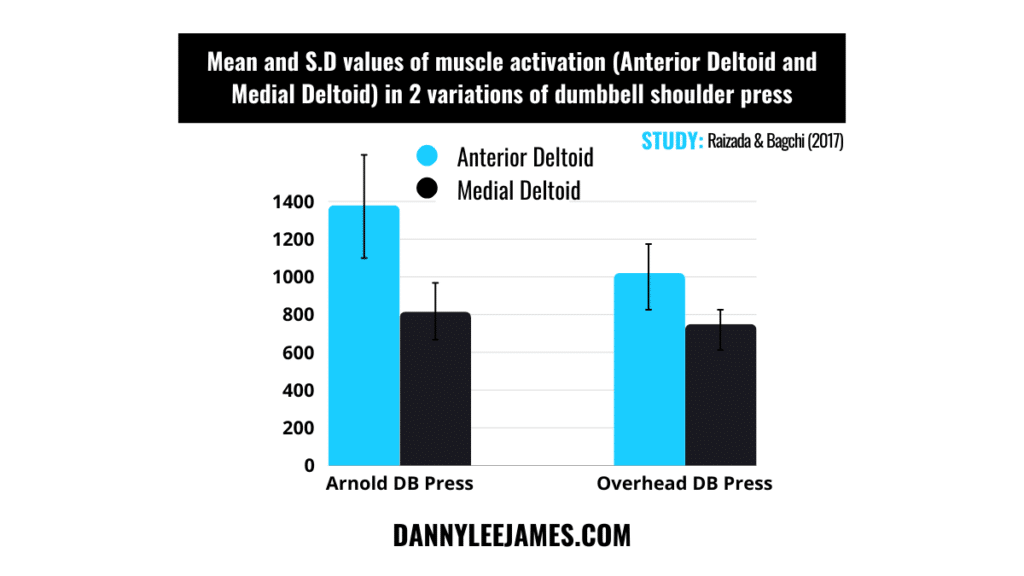
Anterior Deltoid
The front delts are the primary muscle working during overhead pressing movements. The anterior deltoid plays a key role in lifting the arms forward and upward. When performing the Arnold press the front delts initiate the movement and help to bring the arms together again at the top.
Medial Deltoid
The middle delts become increasingly involved once the front delts initiate the movement, bringing the arm upwards, outwards, and slightly internally rotated.
Posterior Deltoid
The rear delts lift the arm backwards and help stabilise loads overhead. While not directly analysed in this study, they’re likely most involved near the lockout position. I wouldn’t expect significant hypertrophy of the rear delts in overhead pressing motions.
It’s worth noting when performing initial-range partials or presses on a high incline, the altered angle of resistance may reduce posterior delt recruitment.
Related: Delt Raises: How Different Hand Grips and ROM Used Can Effect Muscle Activation
Trapezius
The trapezius muscles provide shoulder girdle support during all arm movements. During overhead dumbbell presses, they’re most active during elevation at the top of the press and holding the dumbbells in place at lockout.
They may be also less involved as the direction of load moves toward more of an incline-pressing motion.
Triceps
The triceps will contribute to stabilising and extending the elbows but I wouldn’t bank on significant hypertrophy with Arnold press variations. The triceps will be more involved during machine or barbell press variants with increased lateral force demands at the elbow.
Rotator Cuff
The four muscles of the rotator cuff act as a dynamic stabiliser to keep the humerus in its socket during arm movements and supporting loads. They also help to rotate the arms and assist with raising the arms at the start of the press.
Does The Arnold Press Work All Three Deltoid Heads?
The three regions of the deltoid muscle converge across the shoulder joint from a broad origin. Depending on the arm path, they can have a primary role in arm motion and a stabilising role to help control movement (3).
This is best described by Ackland & Pandy (2010):
Although the deltoid may not be capable of generating substantial axial rotation torque, its small moment arms may lend themselves to stabilizing function. The three deltoid sub-regions are active during abduction, flexion and axial rotation and generate antagonistic “stabilizing” torque by muscle co-activation. For example, when the humerus is internally rotated in the coronal plane under the action of the subscapularis, the deltoid sub-regions generate an opposing external rotation torque. This antagonistic function may generate a force-couple in the transverse plane, resulting in concavity compression of the glenohumeral joint and thus more stable, controlled movements.
So, while most vertical pressing derivatives involve all three heads of the deltoid muscle, the degree to which they contribute to muscle hypertrophy will depend on the factors we’ve discussed above, including:
- Direction of resistance
- Arm path
- Range of motion used
The side and rear delts don’t move through significant ranges or lengths during many shoulder press exercises. So, to achieve full muscular development of the shoulders, a program featuring a combination of presses and raises for each deltoid portion is recommended.
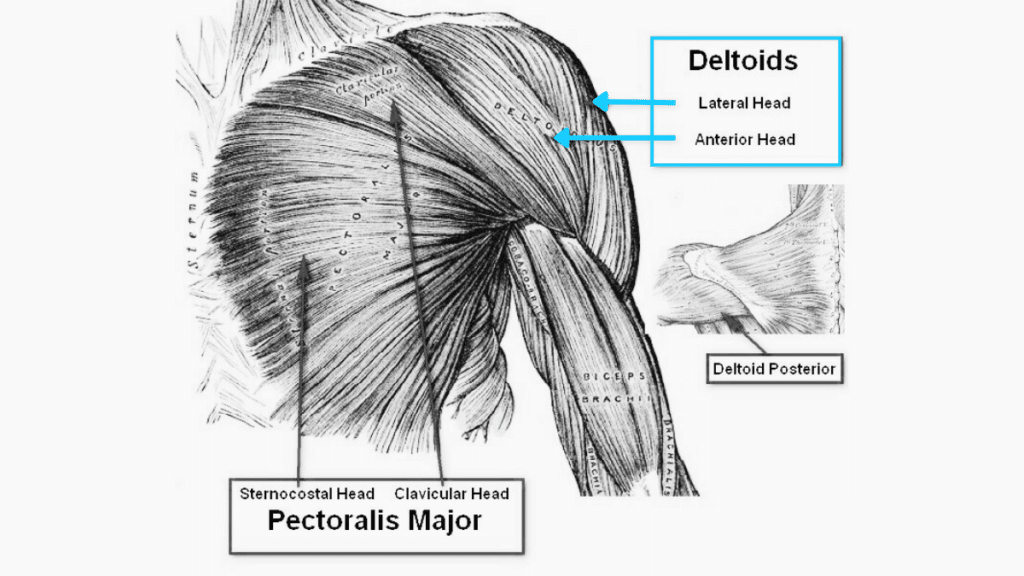
Arnold Press vs Dumbbell Shoulder Press
While both the Arnold Press and the standard Dumbbell Shoulder Press are effective shoulder exercises, they have a few key differences:
- Range of Motion: The Arnold Press involves a rotation and an arm path that the traditional shoulder press does not.
- Muscle Activation: The Arnold Press activates the anterior and medial deltoid muscles more, as indicated in a study comparing EMG activity among these exercises.
- Skill Level: Because of its complexity, the Arnold Press may require a bit more coordination and skill, which could be more suited for advanced exercisers.
Knowing the differences can help you decide which exercise aligns best with your current training needs.
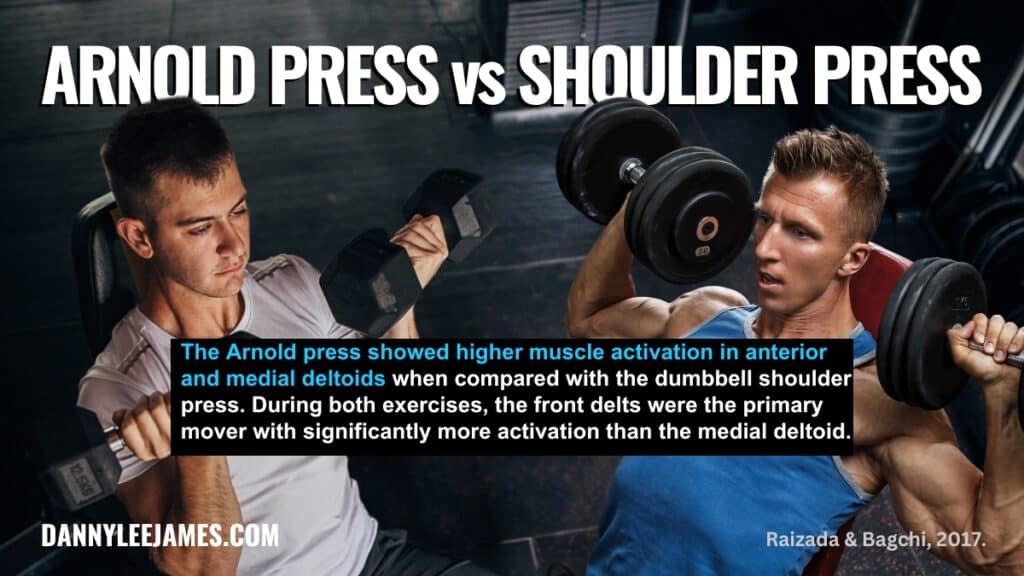
Benefits of the Arnold Press
The Arnold Press is a multifaceted exercise that enhances shoulder strength and adds variation to your shoulder workouts. The fuller range of motion of this shoulder press variation adds more mass to the front and side delts compared to when using a standard shoulder press.
It’s a worthwhile addition to your shoulder routine if you’d like some variety and a lower load option with slightly better hypertrophy outcomes.
How to Perform the Arnold Press Safely
Executing the Arnold press exercise with proper form and attention to movement is crucial for targeting the right tissues and reducing injury risk.
Arnold Press Proper Form and Technique
To begin the Arnold Press, sit or stand with your palms facing you at shoulder height. As you press the dumbbells overhead, rotate your wrists so that your palms face forward at the top of the movement. Ensure a full range of motion by extending the arms and locking out your elbows. Lower the weights back to the starting position with a controlled eccentric phase while reversing the wrist rotation.
- Starting Position: Dumbbells at shoulder height, palms facing you and close.
- Press: Extend arms straight upward and back while rotating wrists and end with palms facing forward, keeping the trunk rigid.
- Eccentric Phase: Bring the dumbbells back down while rotating and return to the starting position with control.
When performing any shoulder press variation, seated or standing, it’s important to gently brace your core to prevent any excessive arching in your mid-lower back. Not only will you avoid exacerbating existing issues in the lower back, but you’ll also ensure you’re stimulating the target muscles.
If you do experience back pain during standing presses, this may be quickly alleviated when the exercise is performed seated with back support and feet up on a step in front of you. You’re also encouraged to seek an assessment and advice from a qualified physiotherapist to get to the root cause.
Common Arnold Press Mistakes
Avoid rushing the movement or using momentum to lift the weight, as this can lead to compromised form and potential injury. Push the dumbbells straight up and back, and be mindful of a wide arching direction.
- Do Not Rush: Maintain controlled movements through a full range of motion.
- Press Up: Press the dumbbells directly upwards in a straight line while rotating.
- Elbow Position: Start with elbows close to the body and avoid flaring the elbows when pressing.
Arnold Press Variations
Seated vs Standing Arnold Press: Which Is Better?
Both seated and standing variations of the Arnold Press have their benefits. Seated Arnold Press provides stability through the back support, allowing more focus on shoulder engagement.
The standing Arnold Press engages the core for stability, and may occasionally allow a little assistance from your legs with a slight dip and drive. Your choice should depend on your fitness goals and level of experience.
- Seated: More stability, concentrated shoulder focus.
- Standing: Engages core and maybe leg drive, whole body, and develops vertical pressing strength.
While research has shown muscle activation is higher during standing dumbbell presses than seated, the Arnold press wasn’t included (4). Performing a seated Arnold press allows you to set the backrest to 70-80 degrees and train the front delts more through the initial range.
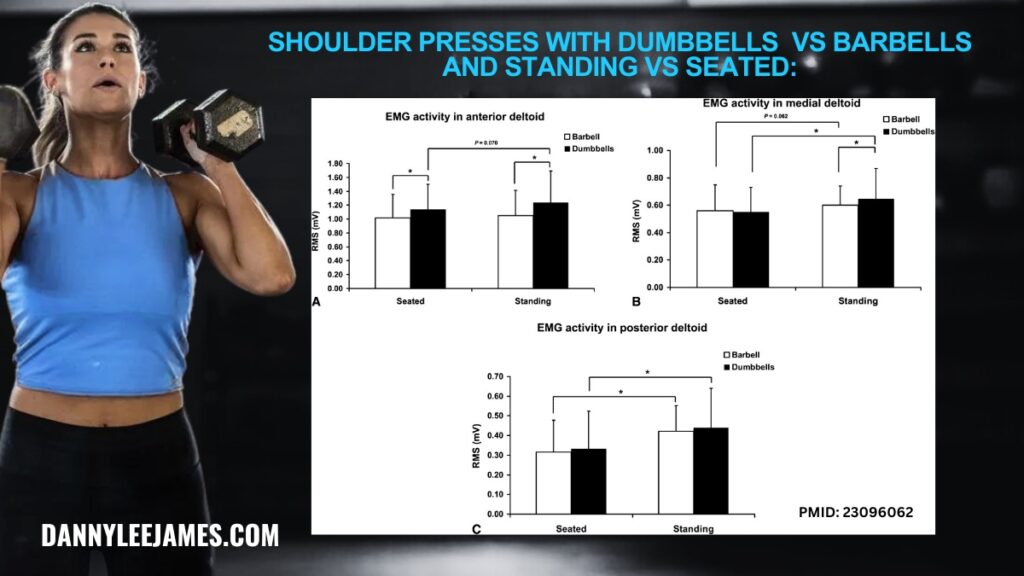
Seated Shoulder Press
Seated shoulder press machines provide a more stable version than most pressing options. Each contraption can differ in arm path used, load direction, and which portion of the strength curve it emphasises. Guided resistance removes a lot of the instability, providing a more consistent technique and making it easier to push heavier loads close to failure. You can also be sure you’re mostly targeting the intended tissues.
Related: Rise of the Machines VS Free Weights
Mastering Two Variations of Dumbbell Shoulder Press
The unique arm path and range of motion used is a big part of why there’s any benefit to the Arnold press. The increased range of motion leads to more muscle hypertrophy of the front and side delts compared to standard shoulder presses.
But you’re only going to get so much out of an exercise for so long and eventually you’ll have to swap out it for a fresh variant to continue making progress. There’s no need to limit yourself to one type of vertical press when there are many productive variants available that may be more appropriate at different stages of your program.
Whether you choose to use it or not depends on a few factors, including:
- Long and short-term training goals
- Phasic considerations (heavy strength, hypertrophy/strength-endurance)
- Stimulus vs fatigue
- Skill or experience with the movement
- Pain or injury status
- Boney considerations (can you get into the required positions?)
- Equipment availability
- Enjoyment
Having a variety of pressing derivatives to cycle through can help avoid stagnation, reduce the likelihood of overuse injuries, and help you set new and enjoyable training targets.
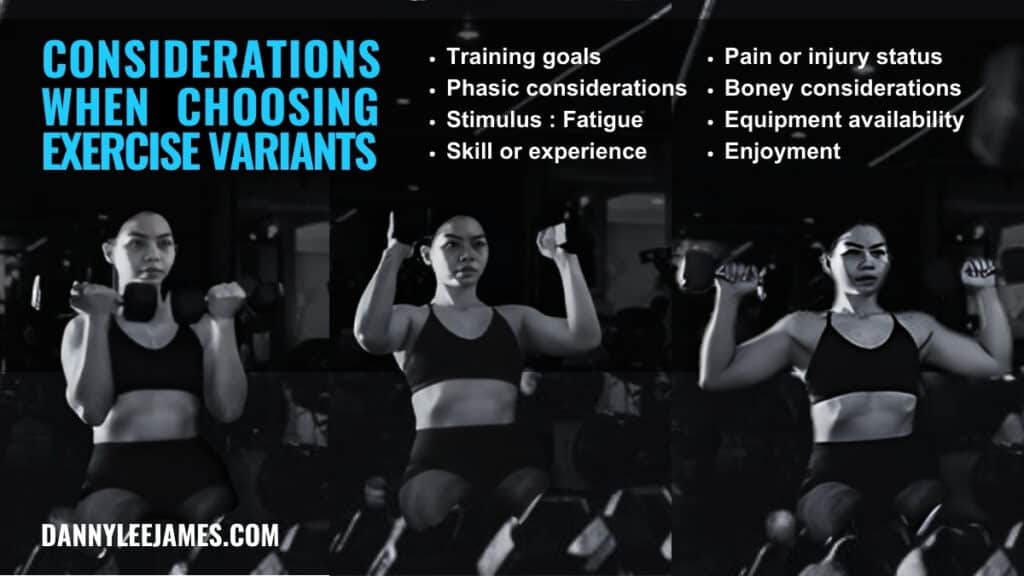
Best Press Exercise For Your Shoulder Routine?
In summary, the Arnold press is a good option if you’re looking for some shoulder hypertrophy and variation in your shoulder routine. As a pure strength exercise, you may not be able to press as much total weight and there is some complexity to contend with. For the seasoned lifter, it may be a nice change of pace and a lower-load option to keep in the pocket.
Hasta la vista.
Related
- Seated Arnold Press: How to do That Weird Dumbbell Shoulder Press Exercise
- Seated Leg Curl vs Lying Leg Curl For Hamstring Muscle Growth
- How Low Should You Squat? Rethinking Squat Depth Lore
- Mass Missive: Free Muscle-Building Email Series
- Delt Raises: How Different Hand Grips and ROM Used Can Effect Muscle Activation
References
- Comparison among the EMG Activity of the Anterior Deltoid and Medial Deltoid During Two Variations of Dumbbell Shoulder Press Exercise. Raizada & Bagchi (2017).
- Moment Arms of the Muscles Crossing the Anatomical Shoulder. Ackland, et al. 2008
- Moment Arms of the Shoulder Muscles During Axial Rotation. Ackland & Pandy (2010).
- Effects of body position and loading modality on muscle activity and strength in shoulder presses. Saeterbakken & Fimland (2013).
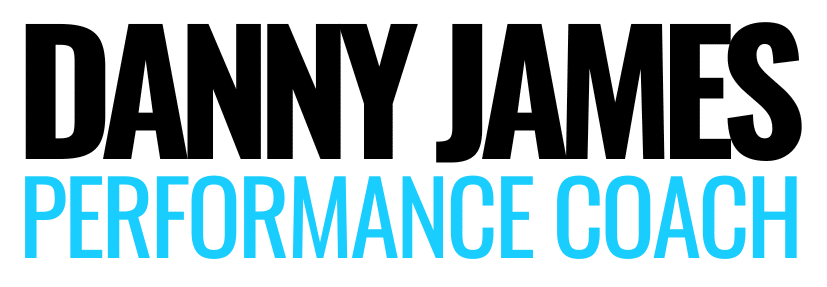
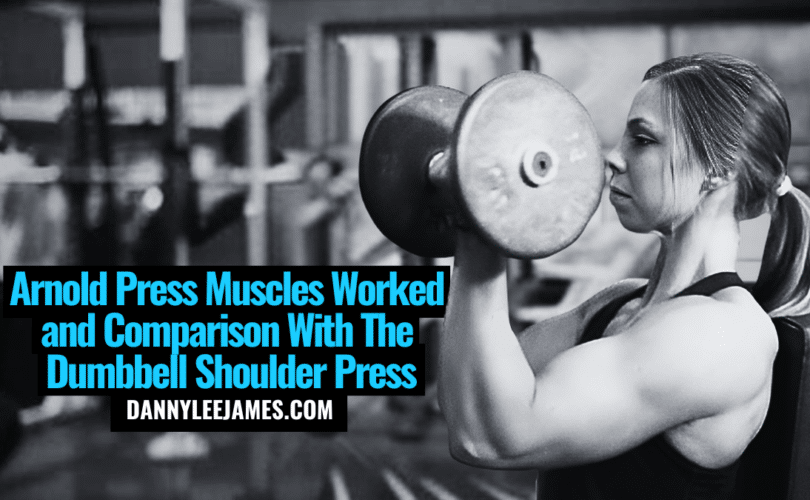

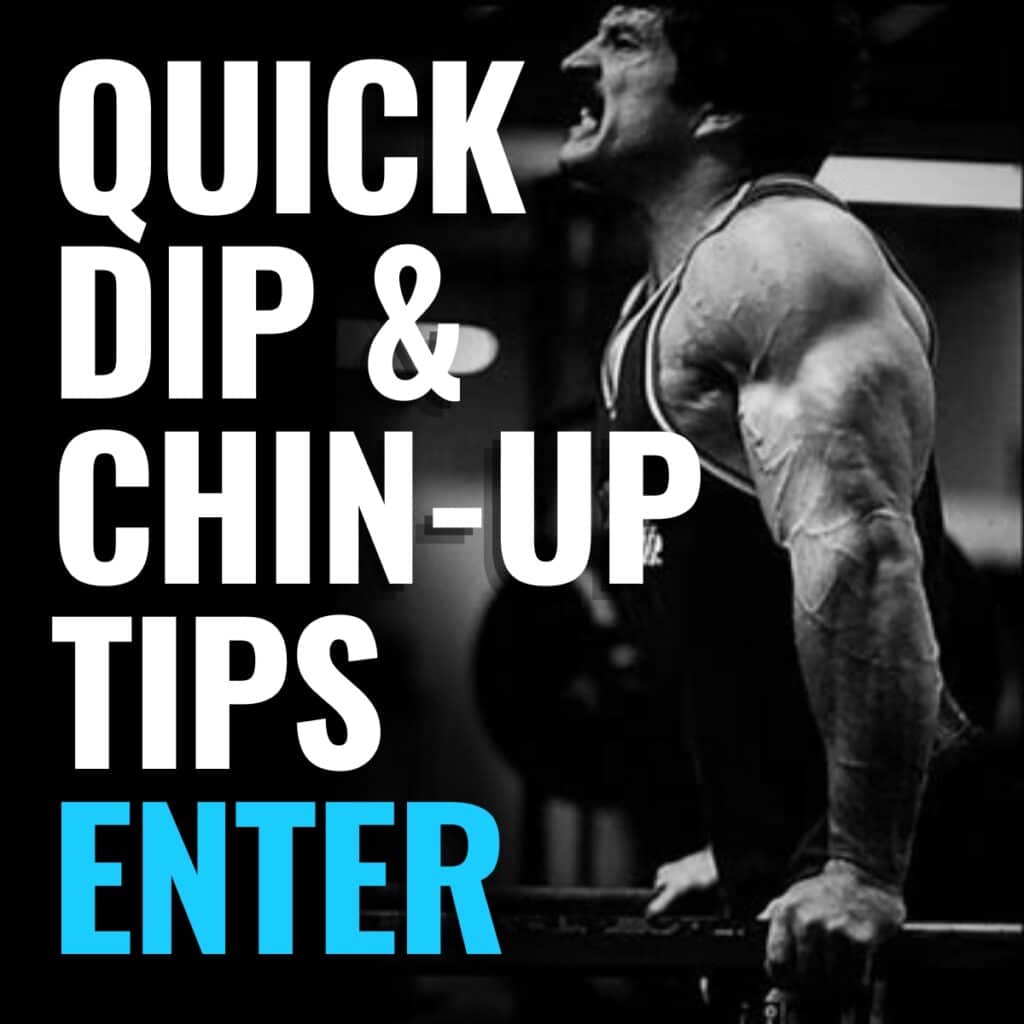

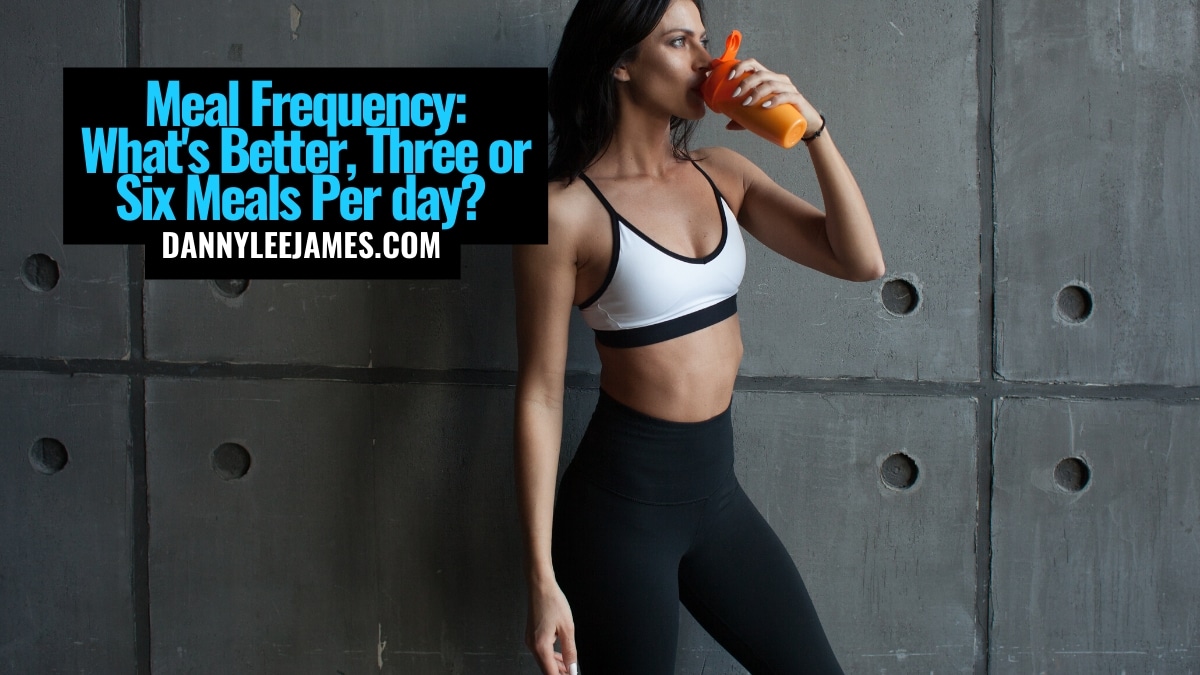


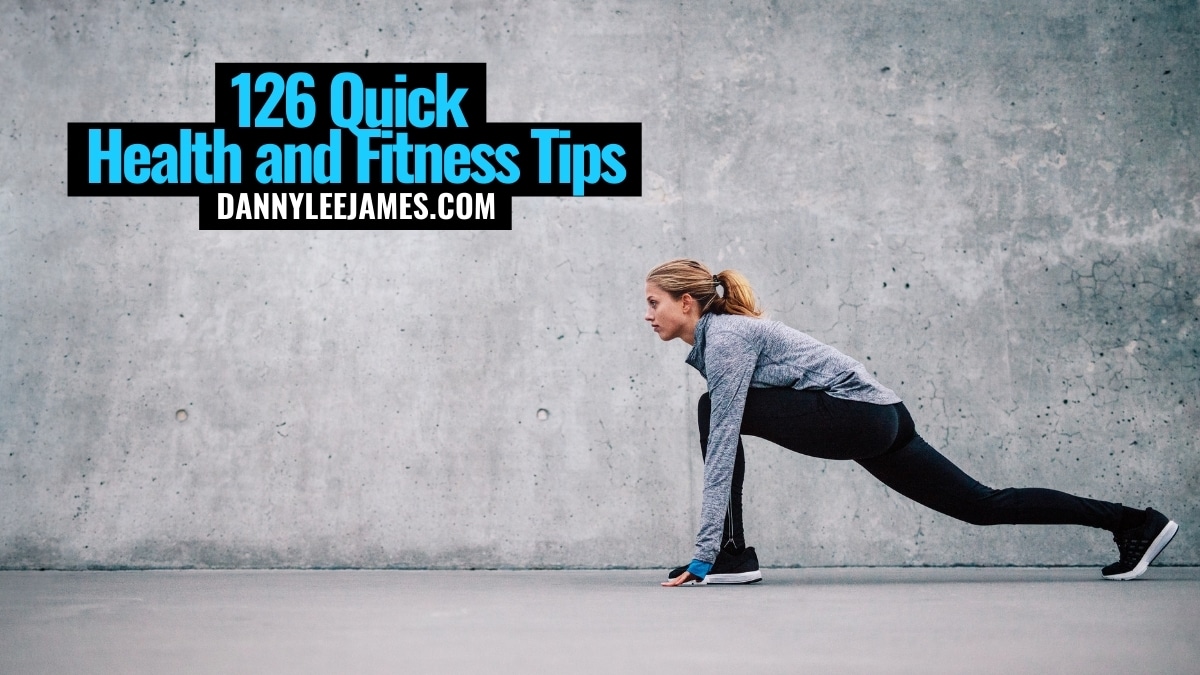
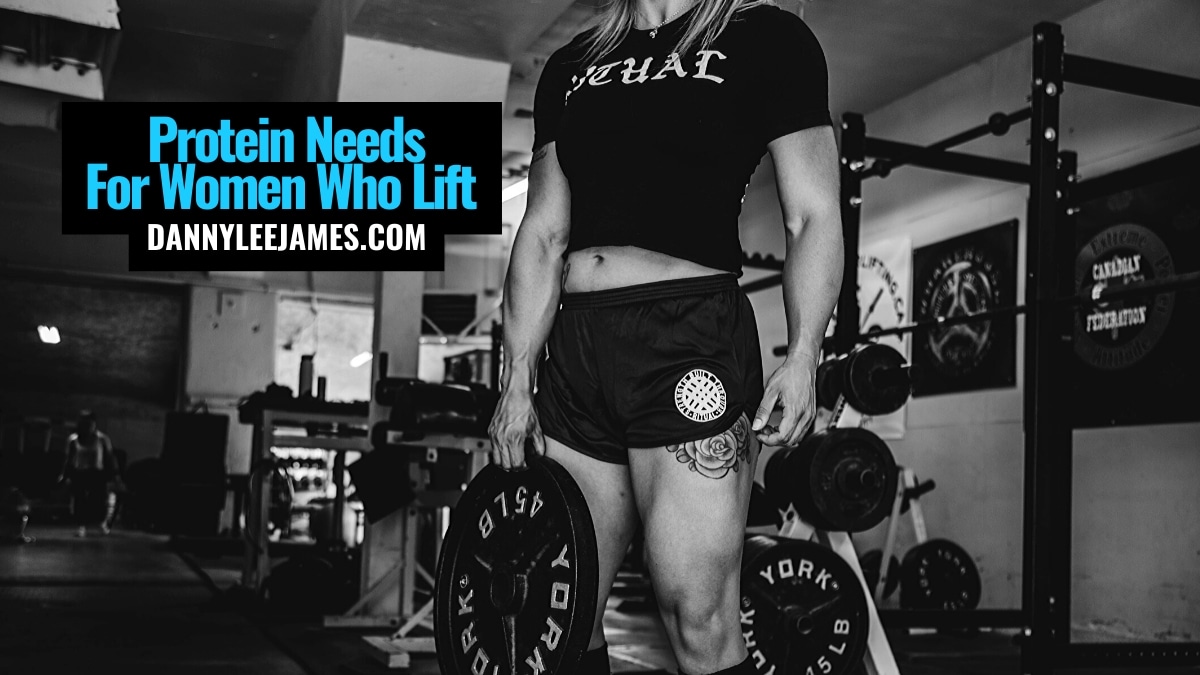
[…] Related: Arnold Press Muscles Worked and Comparison With the Dumbbell Shoulder Press […]
[…] Arnold Press Muscles Worked and Comparison With the Dumbbell Shoulder Press […]
[…] Arnold Press Muscles Worked and Comparison With the Dumbbell Shoulder Press […]
[…] Arnold Press Muscles Worked and Comparison With the Dumbbell Shoulder Press […]
[…] Rotate […]